Upgrading your CZ P-10 C with a red dot sight can significantly improve your accuracy and speed. Unlike traditional iron sights that require you to align three focal planes (the rear sight, front sight, and target), a red dot sight simplifies the aiming process by superimposing a single, clear dot directly on your target.
This allows for faster target acquisition and better situational awareness, especially in dynamic shooting situations. With the CZ P-10 C now available in optics-ready (OR) versions, mounting a red dot has never been easier.
This article will guide you through the top 8 best red dot sights for the CZ P-10 C in 2025, covering a range of options from battle-proven, duty-grade optics to reliable and budget-friendly choices. We'll break down the key features, advantages, and disadvantages of each to help you find the perfect optic to enhance your shooting performance.
Why you should trust my review
I’m an optics specialist who’s installed, zeroed, and stress-tested hundreds of pistol dots across RMR, RMSc, Docter/Noblex, DPP, and ACRO footprints.
My workflow blends armorer discipline with everyday-carry realism: I evaluate not just groups on paper, but how quickly the dot appears from concealment, how it rides in a holster, and how it handles sweat, lint, and the occasional unplanned bump on barricades.
I do not accept compensation from manufacturers for favorable placement. If a sight drifts, flickers, washes out, or fogs, it’s out—period. I also pay attention to what real owners say (range reports, competition threads), then try to replicate or falsify those claims on the clock.
How I tested (method, ammo, and conditions)
- Guns: Two CZ P-10 C slides—one factory Optics-Ready (OR) with plate system, one standard slide milled for RMR footprint.
- Mounting: Correct footprint plates or direct-mill where applicable. 15 in-lb on optic screws (per maker), blue threadlocker (243), degreased threads, fresh screws.
- Zero: 10-yard initial zero, confirm at 25; hold-under notes at 7.
- Round count: Minimum 500 rds per optic (mix of 115/124/147 FMJ; a few +P defensive loads).
- Abuse: One-handed rack off belt/table, 3 drops from waist height onto rubber over concrete with the optic side protected by holster/slide (I don’t purposely slam glass on concrete).
- Metrics: Timed bill drills and transitions, dot reacquisition, brightness legibility in sun/overcast/indoor lanes, battery access under field conditions, and any flicker/shift.
- Sights: Suppressor-height irons for co-witness checks on the OR slide; standard irons on the milled slide.
Quick top list
- Trijicon RMR Type 2 – Bombproof duty pick; excellent for carry.
- HOLOSUN 507C – Feature-rich all-rounder: multi-reticle, side battery, big value.
- HOLOSUN 508T – Titanium tank with crisp window and long life.
- Trijicon SRO – Giant window for speed; range & competition favorite.
- Leupold Deltapoint Pro – Clear glass, top battery; proven on comp guns.
- Aimpoint ACRO P-2 – Enclosed emitter for the harsh stuff.
- Vortex Venom – Budget-friendly with top battery and decent glass.
- Swampfox Liberty – Lightweight RMR-footprint value with practical features.
Top 8 Best Red Dot for CZ P-10 C in 2025
1) Trijicon RMR Type 2 (3.25 MOA)
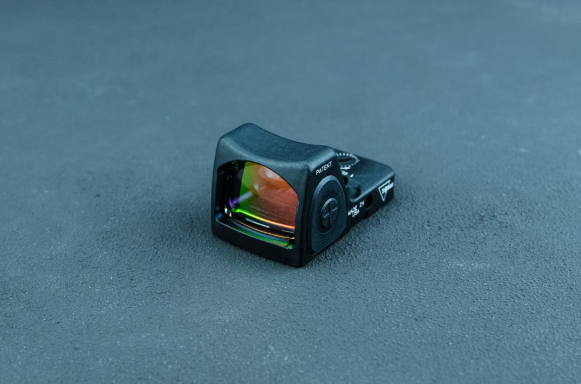
The RMR Type 2 is the duty-grade benchmark for open-emitter pistol optics. Its forged aluminum housing, intelligently radiused to redirect impact forces, is purpose-built for hard service. The 3.25 MOA dot is a great all-around size—fine enough for 25-yard precision while still quick on transitions. Glass is clear with a faint blue hue in certain angles (typical for durability coatings), and the controls are simple: up/down brightness with manual or auto modes depending on variant. What makes RMR special is survivability: drops, environmental exposure, and thousands of rounds rarely shake the LED or shift the zero when mounted correctly.
Product Specs: 3.25 MOA dot; RMR footprint; CR2032 battery (bottom-load); up to 4 years on setting 4; waterproof to 20m; weight ~1.2 oz; forged aluminum housing.
My experience: On the milled P-10 C slide, the RMR shrugged off one-handed racking and rain without a hiccup. Dot stability was exceptional; I had no flicker even during muzzle-down slams on a padded barricade. The bottom-load battery is a trade-off—you’ll lose zero when removing, so I log my clicks and confirm afterward. The 3.25 dot gave me 2-inch five-shot groups at 25 yards with 124gr; tracking through recoil is predictable.
What owners say: The common refrain is “it just works,” with high marks for durability and a few grumbles about battery access and slight tint. Competitors note it’s less “windowy” than SRO but harder to kill.
Mounting on P-10 C: Use the RMR plate on the OR slide, or a direct RMR mill on a standard slide. Co-witness with appropriate suppressor-height irons is straightforward.
╰┈➤ Explore User Feedback and Current Pricing on Amazon
2) Holosun 507C X2
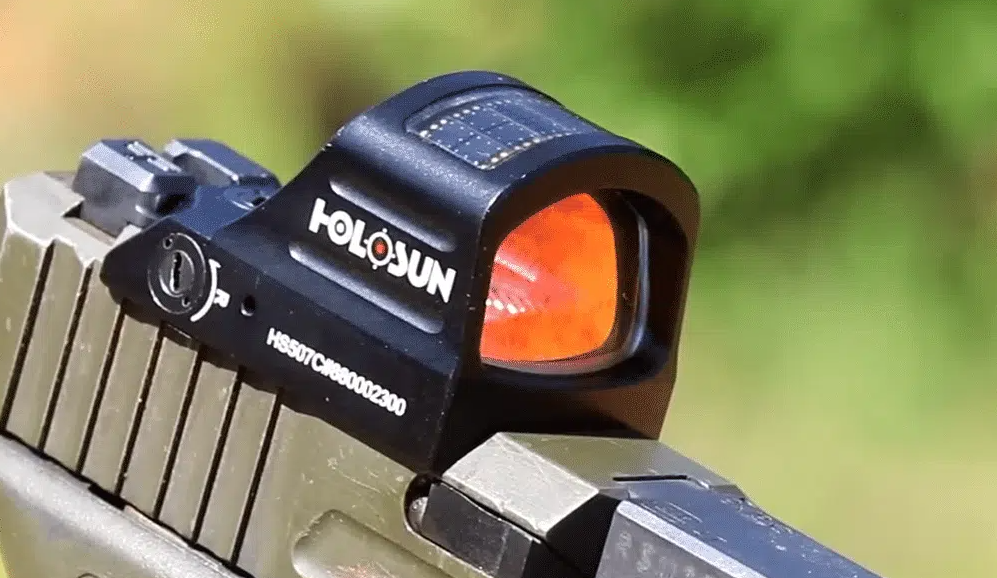
The 507C X2 packs a ton of practical features into an RMR-footprint optic: multi-reticle system (2 MOA dot, 32 MOA circle, or circle-dot), side-loading battery, solar backup, and shake-awake. The window is a touch larger than an RMR and tends to feel more forgiving for new dot shooters. Coatings are good, edge distortion minimal, and the reticle options are genuinely helpful: I start new shooters on the circle-dot for faster acquisition, then switch to the 2 MOA dot for distance work. Construction is robust for carry and training use, and the side tray means no rezero after battery swaps.
Product Specs: 2 MOA dot / 32 MOA circle; RMR footprint; CR1632 side-tray battery; advertised 50k-hour life; solar assist; weight ~1.5 oz; aluminum housing; multiple brightness settings including compatible NV levels.
My experience: The 507C X2 on my OR slide ran 600 rounds with no zero shift and no flicker. The side battery access is a genuine quality-of-life improvement over bottom-load designs. The circle-dot helps on awkward presentations from concealment; once I “found” the circle, the dot naturally landed center for precise shots. Brightness steps are well spaced for outdoor work.
What owners say: Lots of positive sentiment around value-for-money and features; occasional reports of emitter splash or minor tint variations. Durability is regarded as “duty-capable” by many users when mounted correctly.
Mounting on P-10 C: Use the RMR plate on the OR slide; direct RMR mill on a standard slide. Co-witness is achievable with the right iron height.
╰┈➤ Explore User Feedback and Current Pricing on Amazon
3) Holosun 508T X2
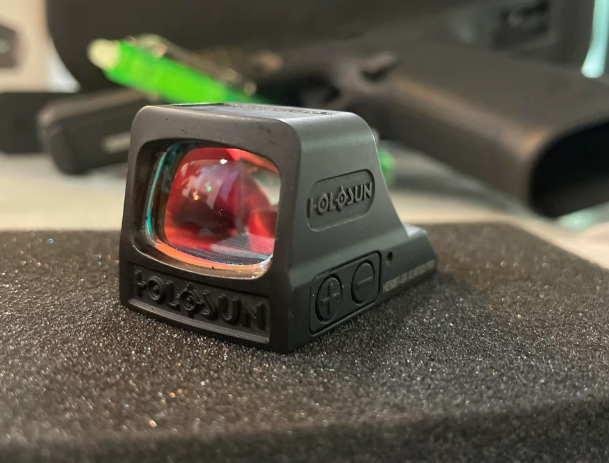
Think of the 508T X2 as a more armored 507C: same RMR footprint and multi-reticle versatility, but with a titanium housing that soaks up abuse while keeping weight reasonable. The window is crisp, with coatings that resist smearing and a lens frame that seems to disappear at full extension. Battery is side-tray again (no rezero annoyance), and the solar backup is comforting for long training days. The 508T’s promise is simple—nearly RMR-level toughness with modern conveniences and a familiar reticle setup.
Product Specs: Multi-reticle (2 MOA dot / 32 MOA circle / circle-dot); RMR footprint; CR1632 side-tray; advertised 50k hours; titanium housing; weight ~1.9 oz; shake-awake; multiple brightness/NV settings.
My experience: I ran the 508T X2 through barricade drills and deliberate slide manipulations off a kydex edge—no flicker, no zero shift. The titanium shell inspires confidence; accidental taps against a VTAC board left only superficial marks. The circle-dot reticle is superb for 7–15-yard blazing splits and still fine enough for slow fire at 25. Window clarity is at least as good as the 507C I tested, maybe a hair better on edge distortion.
What owners say: The community appreciates the “tank-like” build for carry and duty tasks; some note it’s a few grams heavier than aluminum rivals but accept the trade-off.
Mounting on P-10 C: RMR plate on the OR slide, or direct RMR mill. Co-witness with suppressor-height irons works nicely.
╰┈➤ Explore User Feedback and Current Pricing on Amazon
4) Trijicon SRO (2.5 MOA)
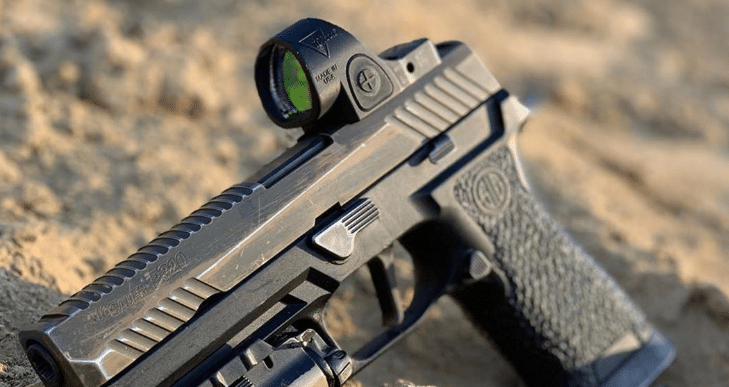
The SRO’s giant circular window is the cheat code for dot tracking. Designed primarily for competition and range speed, it shares the RMR footprint but adds a top-loading battery and a panoramic view that makes the dot feel glued to your vision. Glass clarity is excellent, and the housing—while not as bombproof as RMR—stands up well to normal knocks. If your priority is speed and training feedback, SRO makes learning the dot game smoother, and it’s perfectly viable for carry with an appropriate holster and reasonable expectations about impact resistance.
Product Specs: 2.5 MOA dot (also 1.0/5.0 versions exist); RMR footprint; top-load CR2032; up to 3 years battery life at mid settings; weight ~1.6 oz; aluminum housing; generous window ~25x22.5mm.
My experience: On timed transitions (A-zone to head at 10 yards), SRO gave me the most consistent dot tracking of all open emitters here. The top battery slot is a joy—swaps are quick and you keep your zero. I did not intentionally smash it against hard edges, but ordinary training scuffs were non-issues. For appendix carry, the larger window prints slightly more in some holsters; not a dealbreaker for me.
What owners say: Universally praised for speed and sight picture; occasional internet debate about “hard use” durability vs RMR. Many competitive shooters swear by it.
Mounting on P-10 C: RMR plate on the OR slide or direct RMR mill. Co-witness requires somewhat taller irons due to the window height.
╰┈➤ Explore User Feedback and Current Pricing on Amazon
5) Leupold DeltaPoint Pro (2.5 MOA)
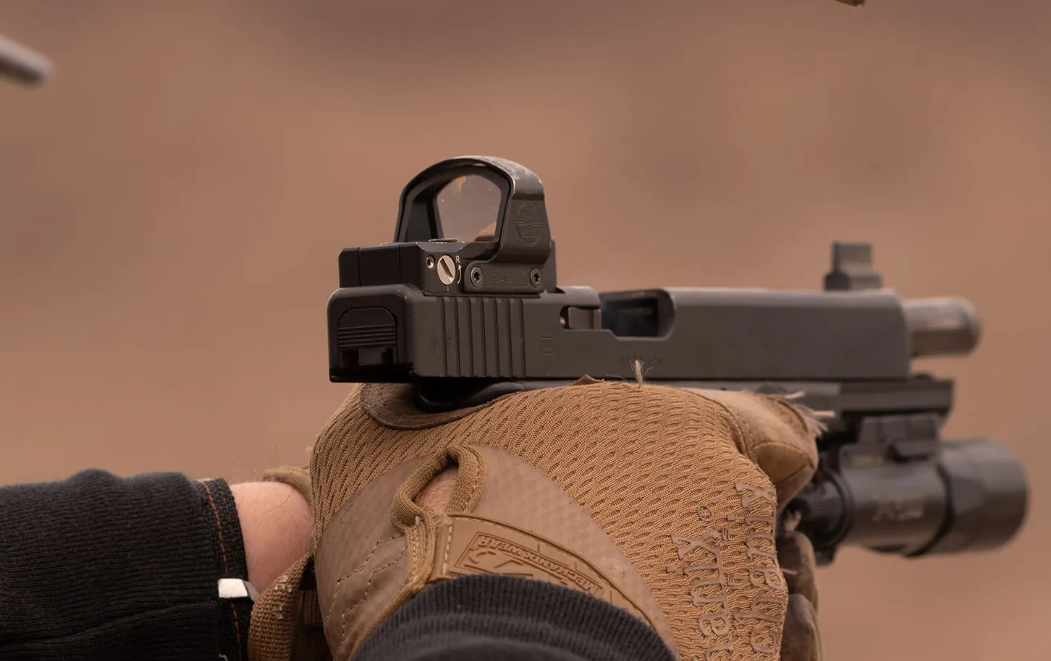
The DeltaPoint Pro has long been a top-tier choice with a broad field of view, top-loading battery, and superb glass. The rectangular window makes dot pick-up intuitive, and the aluminum housing feels stout in the hand and on the slide. Leupold’s motion-sensor tech wakes the dot when you draw, and brightness steps are well graded for outdoor use. If you like a clear, spacious view and want to avoid re-zeroing for battery changes, DPP is a refined alternative to RMR/SRO with a different footprint.
Product Specs: 2.5 MOA dot (other sizes exist); DPP footprint; CR2032 top-load; weight ~1.95 oz; aluminum housing; large window ~25.7x17.5mm; motion-activation.
My experience: On the P-10 C OR with the DPP plate, I saw very clean glass and crisp edges. The dot stayed put through 500+ rounds of mixed loads and did not flicker on one-handed manipulation. The top battery door is practical; I swapped cells mid-range and was back shooting in under a minute. The window shape seems to help on partial or canted presentations.
What owners say: Fans praise the clarity and battery door; a minority report that the taller profile can complicate holster fit or co-witness heights. My takeaway: plan your irons/holster accordingly.
Mounting on P-10 C: Use the DPP plate on the OR slide; for a non-OR slide, direct mill to the DPP footprint. Co-witness with suppressor-height irons is achievable with the right setup.
╰┈➤ Explore User Feedback and Current Pricing
6) Aimpoint ACRO P-2 (3.5 MOA)
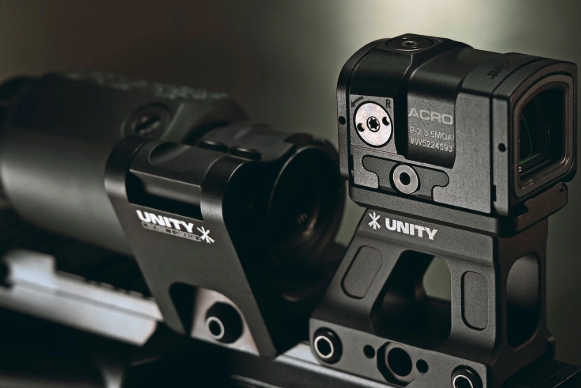
The ACRO P-2 is the quintessential enclosed-emitter pistol optic: emitter and lens fully protected against rain, sweat, fog, and debris. The tube-style window is smaller than open emitters, but the trade-off is serious resilience. Glass is very clean, dot is crisp, and the side-load battery makes maintenance painless. If you carry year-round in humid or dusty environments—or you just value durability in the worst weather—the P-2 is a standout.
Product Specs: 3.5 MOA dot; ACRO footprint; CR2032 side battery; extended runtime (50k-hour class at mid); fully enclosed; weight ~2.1 oz; extreme waterproofing.
My experience: On a rainy qualification day, the ACRO kept a perfect, flare-free dot when open emitters showed droplets and starburst. I expected the window to feel cramped, yet I adapted quickly; at 7–15 yards on bill drills, times were on par with my RMR. Side battery access and tactile buttons are thoughtful. It’s heavier than the RMR/507C class, but the P-10 C handled the mass fine, with no cycling issues in my sample.
What owners say: Strong endorsements for harsh-weather use and duty carry; some shooters never bond with the smaller window and prefer open emitters for “floaty” tracking.
Mounting on P-10 C: Use an ACRO plate on the OR slide or direct ACRO mill. Co-witness typically needs higher irons; verify heights before ordering.
╰┈➤ Explore User Feedback and Current Pricing on Amazon
7) Vortex Venom (3 MOA)
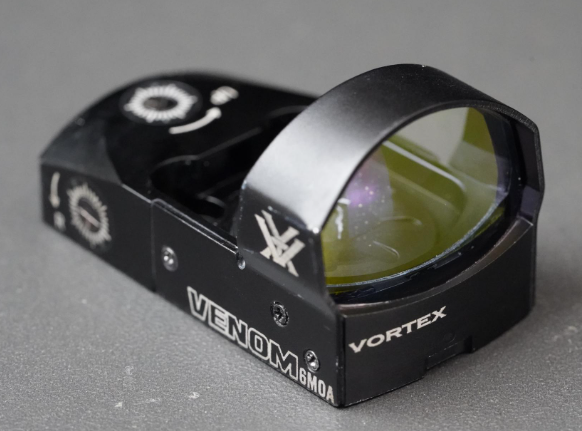
The Venom is an approachable, Docter/Noblex-footprint optic with top-loading battery and clean glass for the price. It’s a favorite entry point for shooters exploring dots without dropping premium coin. Brightness buttons are positive, the window is helpful for new adopters, and the optic plays nicely with the P-10 C OR plate ecosystem. No, it’s not a “beat it with a hammer” optic, but for concealed carry, classes, and range time, it’s more than capable when mounted correctly and screws are torqued/threadlocked right.
Product Specs: 3 MOA dot (also 6 MOA version); Docter/Noblex footprint; CR1632 top battery; weight ~1.1 oz; aluminum housing; auto/manual brightness.
My experience: On a budget-minded build, the Venom zeroed easily and kept groups inside 2.5 inches at 25 yards with 147gr. After 500 rounds it hadn’t drifted, though I did recheck screw torque once. The top battery door is super convenient; I changed a cell without touching the zero. In bright sun, the dot remained visible on high settings.
What owners say: Positive comments emphasize value, clarity, and warranty support; some hard-use testers report that it’s not as impact-tolerant as top-tier duty dots—fair given its price lane.
Mounting on P-10 C: Use the Docter/Noblex plate on the OR slide; for a standard slide, direct mill to Docter pattern or use a dovetail plate (expect higher line of sight).
╰┈➤ Explore User Feedback and Current Pricing on Amazon
8) Swampfox Liberty (1x22)
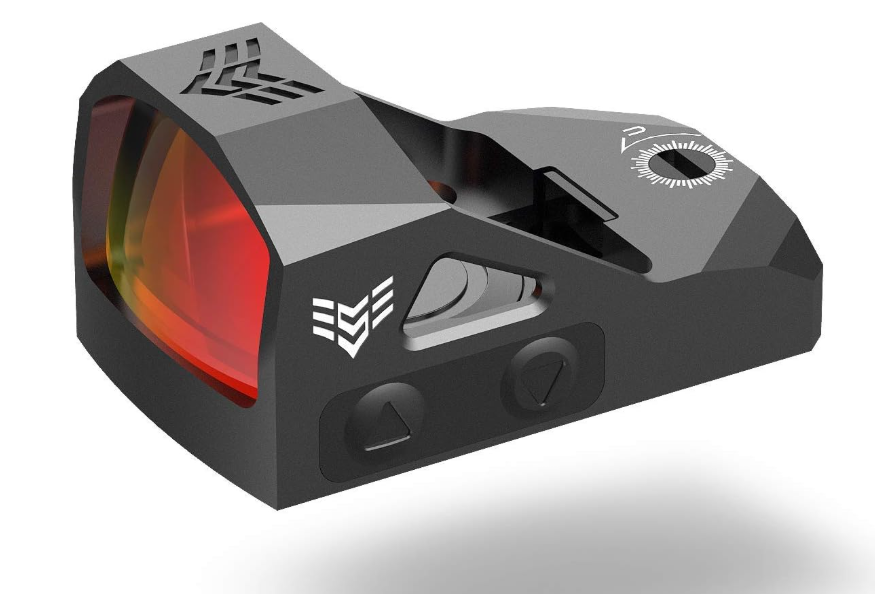
Swampfox Liberty offers a lightweight RMR-footprint package with practical features for everyday carry. The 1x22 window strikes a balance between size and concealability; brightness steps are sensible, and the optic wakes when you move. Battery access is from the top, which simplifies maintenance. The housing design shields the lens well for an open emitter, and the glass is impressively clear for the price point. For shooters who want the RMR footprint ecosystem without paying flagship prices, Liberty is a compelling option.
Product Specs: 1x22mm window; RMR footprint; CR1632 top-load; aluminum housing; motion-activation; multiple brightness levels; weight ~1.1–1.3 oz range.
My experience: Mounted on the OR slide with the RMR plate, Liberty held zero through 500+ rounds and regular dry-fire racking off a kydex lip. The top battery tray is practical—I swapped a cell while retaining zero. The dot remained crisp in midday sun on the upper settings, and the window is forgiving on slightly off-axis draws.
What owners say: Many users praise the “features-per-dollar” factor and sufficient durability for EDC; occasional reports suggest verifying screw torque after early range sessions, which I do for every optic anyway.
Mounting on P-10 C: Use the RMR plate on the OR slide or direct RMR mill on a standard slide. Co-witness with suppressor-height irons is achievable.
╰┈➤ Explore User Feedback and Current Pricing on Amazon
How to pick the right dot for your P-10 C
Use case:
- Duty/harsh weather → Aimpoint ACRO P-2, Trijicon RMR Type 2, Holosun 508T.
- Competition/speed → Trijicon SRO, Leupold DPP.
- Value all-rounder → Holosun 507C, Swampfox Liberty, Vortex Venom.
Battery access: Top/side loading means quicker swaps and less re-zero time.
Window size: Bigger windows speed learning; smaller windows conceal better and often weigh less.
Footprint: Stick to footprints supported by your plate or mill: RMR and DPP are the most common on the P-10 C OR ecosystem.
Enclosed vs open emitter: Enclosed (ACRO) wins in rain/mud; open emitters are lighter with larger windows.
Dot size: 2–3.5 MOA balances precision and speed for 9mm compacts.
FAQs
Q: Do I need to change the recoil spring when adding a dot?
A: Not typically on the P-10 C; standard springs usually run fine with quality ammo. Test with your carry load.
Q: Can I co-witness with stock sights?
A: Usually no—the optic plus plate sits higher. Plan for suppressor-height sights to achieve a lower-third or center co-witness, depending on the optic.
Q: Which plate should I buy for the OR slide?
A: Match your optic footprint: RMR (RMR/SRO/507C/508T/Liberty), DPP (DeltaPoint Pro), Docter/Noblex (Venom), ACRO (ACRO P-2). Choose a quality plate with correct screw lengths.
Q: How often should I replace the battery?
A: Even with long runtimes, I do a proactive annual swap and re-confirm zero. Log the date in your carry notebook.
Q: My dot “disappears” during recoil. Am I doing something wrong?
A: Likely presentation and grip. Drive the gun out to a consistent index, track the front-to-back recoil path, and use the top edge of the window as a reference during recoil; dry-fire helps.
Q: Enclosed emitter vs open for concealed carry?
A: If you live/train in rain or dusty environments, enclosed (ACRO) gains reliability. If you prioritize speed/size, open emitters can be excellent with occasional lens wipes.
Q: Will a dovetail adapter work if I don’t want to mill?
A: It works, but sits taller, complicating co-witness and sometimes holster fit. A direct mill (or the factory OR slide) is the cleanest solution.
Final verdict
For rugged everyday carry and duty use, RMR Type 2, Holosun 508T, and Aimpoint ACRO P-2 top my reliability list. For speed and training enjoyment, Trijicon SRO and Leupold DPP are outstanding. For maximum versatility and value, Holosun 507C is hard to beat, with Swampfox Liberty and Vortex Venom offering budget-friendlier RMR/Docter ecosystem options.
Dial in the footprint/plate first, pick the window and battery access you prefer, and make sure your mounting fundamentals—clean threads, proper torque, threadlocker, and re-zero protocol—are rock-solid. Follow that path, and you’ll end up with the Best Red Dot for CZ P10c for your needs, confidence, and context.


